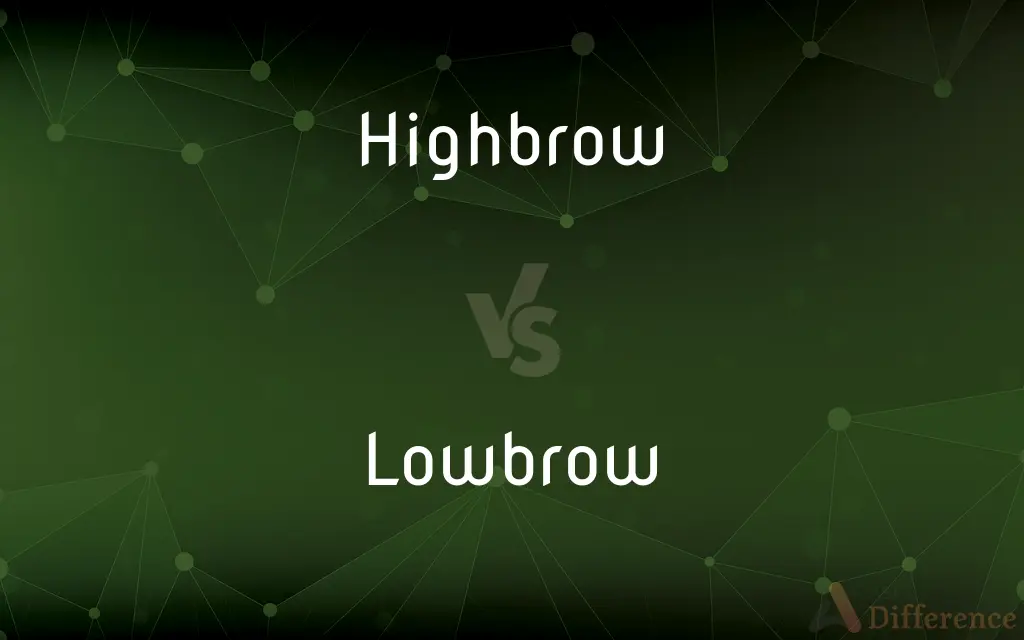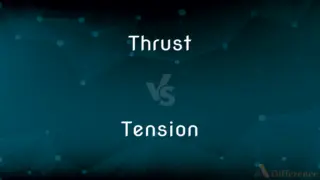Highbrow vs. Lowbrow — What's the Difference?
Edited by Tayyaba Rehman — By Urooj Arif — Updated on April 17, 2024
Highbrow culture refers to sophisticated, intellectual artistic expressions, while lowbrow culture embraces more popular, accessible forms.

Difference Between Highbrow and Lowbrow
Table of Contents
ADVERTISEMENT
Key Differences
Highbrow culture typically includes art forms that require a certain level of education or cultural capital to be fully appreciated, such as classical music, fine arts, and literature. In contrast, lowbrow culture is characterized by its mass appeal and accessibility, often found in popular music, television, and mainstream movies.
The audience for highbrow culture generally consists of individuals who value artistic complexity and depth, which often necessitates a deeper understanding of the context and techniques behind the work. On the other hand, lowbrow culture appeals to a broader audience with its straightforward, entertaining content that is easy to consume and understand.
In terms of content, highbrow culture often tackles complex themes and narratives, requiring reflection and critical thought. Lowbrow culture, however, tends to focus on simpler, more direct messages and stories that are immediately engaging but may lack depth.
From an institutional perspective, highbrow activities are often supported by prestigious institutions like museums, universities, and concert halls, which emphasize cultural preservation and education. Conversely, lowbrow activities are typically supported by commercial enterprises aiming to maximize audience size and profitability.
Highbrow culture is often seen as elitist or exclusive, perceived as only being for those within certain social or educational strata. Conversely, lowbrow culture is viewed as more democratic and inclusive, often celebrated for its wide appeal and accessibility.
ADVERTISEMENT
Comparison Chart
Audience
Educated, culturally informed
General public, mass audience
Art Forms
Classical music, fine arts
Popular music, television
Themes
Complex, requires reflection
Simpler, direct, entertaining
Institutional Support
Museums, universities
Commercial enterprises
Perception
Elitist, exclusive
Democratic, inclusive
Compare with Definitions
Highbrow
Supported by prestigious cultural institutions.
Highbrow art exhibits are typically hosted in renowned museums.
Lowbrow
Often commercial in nature.
Lowbrow music festivals are major draws for large, diverse crowds.
Highbrow
Pertains to sophisticated artistic and cultural expressions.
Enjoying a highbrow night out at the opera.
Lowbrow
Associated with easily accessible, popular art forms.
Lowbrow TV shows are designed for broad entertainment.
Highbrow
Perceived as elitist or exclusive.
Highbrow events often attract a select, often affluent audience.
Lowbrow
Engages through simplicity and entertainment.
Lowbrow comedies use straightforward humor to attract viewers.
Highbrow
Appeals to those with specialized knowledge or education.
Highbrow literature often includes extensive literary references.
Lowbrow
Caters to mass audience appeal.
Lowbrow magazines focus on celebrity gossip and sensational news.
Highbrow
Focuses on depth and artistic complexity.
Highbrow music like classical symphonies require an understanding of musical forms.
Lowbrow
Seen as more inclusive and democratic.
Lowbrow art is appreciated by people from all walks of life.
Highbrow
Used colloquially as a noun or adjective, "highbrow" is synonymous with intellectual; as an adjective, it also means elite, and generally carries a connotation of high culture. The word draws its metonymy from the pseudoscience of phrenology, and was originally simply a physical descriptor.
Lowbrow
One having uncultivated tastes.
Highbrow
Of, relating to, or being highly cultured or intellectual
They only attend highbrow events such as the ballet or the opera.
Lowbrow
Uncultivated; vulgar.
Highbrow
One who possesses or affects a high degree of culture or learning.
Lowbrow
Unsophisticated, not intended for an audience of intelligence, education or culture.
The Three Stooges are known for their lowbrow slapstick humor consisting of foolish action for the masses.
Highbrow
Intellectually stimulating, highly cultured, sophisticated.
Highbrow entertainment
Lowbrow
(countable) Someone or something of low education or culture.
Highbrow
A cultured or learned person or thing.
Lowbrow
An underground populist visual art movement that arose in the Los Angeles area in the late 1960s, inspired by comics, punk music, graffiti, etc.
Highbrow
A person of intellectual or erudite tastes; an intellectual.
Lowbrow
A person who is uninterested in intellectual pursuits
Highbrow
Highly cultured or educated; pertaining to highly educated people; as, highbrow events such as the ballet or opera.
Lowbrow
Characteristic of a person who is not cultivated or does not have intellectual tastes;
Lowbrow tastes
Highbrow
A person of intellectual or erudite tastes
Highbrow
Highly cultured or educated;
Highbrow events such as the ballet or opera
A highbrowed literary critic
Common Curiosities
What defines highbrow culture?
Highbrow culture includes sophisticated, intellectually demanding art forms.
Can someone enjoy both highbrow and lowbrow cultures?
Yes, many people appreciate both for their different qualities.
What is an example of a lowbrow activity?
Watching reality TV is a common lowbrow activity.
What makes art highbrow?
Its complexity, depth, and the need for contextual knowledge.
Why is lowbrow culture popular?
Its accessibility and entertainment value make it broadly appealing.
Why might someone prefer lowbrow culture?
For its straightforward, relatable content and ease of access.
How do institutions influence highbrow culture?
Prestigious institutions preserve and promote highbrow cultural forms.
How does lowbrow culture impact society?
It shapes popular tastes and norms through its wide reach.
Are lowbrow activities less valuable?
They hold cultural significance and provide entertainment, though they might lack the depth of highbrow forms.
Is highbrow culture only for the wealthy?
While often perceived as such, anyone with interest and knowledge can appreciate highbrow culture.
Do highbrow and lowbrow cultures ever overlap?
Elements of each can influence the other, creating hybrid forms.
Share Your Discovery

Previous Comparison
Informer vs. Informant
Next Comparison
Thrust vs. TensionAuthor Spotlight
Written by
Urooj ArifUrooj is a skilled content writer at Ask Difference, known for her exceptional ability to simplify complex topics into engaging and informative content. With a passion for research and a flair for clear, concise writing, she consistently delivers articles that resonate with our diverse audience.
Edited by
Tayyaba RehmanTayyaba Rehman is a distinguished writer, currently serving as a primary contributor to askdifference.com. As a researcher in semantics and etymology, Tayyaba's passion for the complexity of languages and their distinctions has found a perfect home on the platform. Tayyaba delves into the intricacies of language, distinguishing between commonly confused words and phrases, thereby providing clarity for readers worldwide.














































